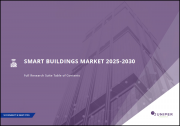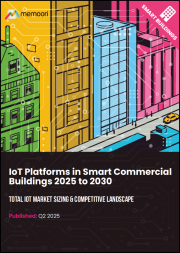
|
시장보고서
상품코드
1734838
세계의 스마트 빌딩 시장 예측(-2032년) : 컴포넌트별, 빌딩 유형별, 전개 모델별, 용도별, 최종 사용자별, 지역별 분석Smart Building Market Forecasts to 2032 - Global Analysis By Component (Hardware, Software and Services), Building Type, Deployment Model, Application, End User and By Geography |
||||||
Stratistics MRC에 따르면 세계의 스마트 빌딩 시장은 2025년에 1,446억 4,000만 달러, 2032년까지는 6,231억 달러에 이를 것으로 예측되며, 예측 기간 동안 CAGR은 23.2%를 나타낼 전망입니다.
스마트 빌딩은 IoT 센서, AI, 빌딩 관리 시스템(BMS)을 통합하여 에너지 사용, 보안, 거주자의 편의를 최적화하는 자동화된 구조입니다. 적응형 조명, HVAC 제어, 예측 유지보수 등의 기능을 통해 운영 비용과 탄소 발자국을 줄일 수 있습니다. 스마트 빌딩은 실시간 데이터 분석을 활용하여 효율성과 지속 가능성을 향상시키고 LEED와 같은 친환경 인증 표준에 부합합니다. 스마트 빌딩은 도시 인프라의 미래를 대표하며 스마트 시티의 거주성과 자원 관리를 개선합니다.
미국 에너지 정보국에 따르면 미국의 상업용 건물은 미국 전체 에너지 소비의 18%를 차지하며, IoT 센서와 건물 관리 시스템(BMS)의 통합으로 에너지 효율이 향상됩니다.
업무 공간 최적화에 대한 수요
에너지 효율적이고 지속 가능한 작업장에 대한 요구가 증가하면서 스마트 건축 자재에 대한 수요가 증가하고 있습니다. 이러한 소재는 열 조절 기능을 향상시키고 운영 비용을 절감합니다. 친환경 인증에 대한 기업의 관심이 높아지면서 시장 채택이 증가하고 있습니다. 자가 치유 콘크리트와 같은 스마트 소재의 혁신은 건물의 내구성을 향상시킵니다. 지속 가능한 건설을 장려하는 정부 규제가 시장 성장을 지원합니다. 스마트 시티를 향한 추세는 첨단 소재에 대한 수요를 촉진합니다. 향상된 거주자 편의성과 생산성은 시장 확대를 촉진합니다.
높은 초기 투자 비용
스마트 건축 자재의 높은 초기 비용은 예산이 제한된 프로젝트에서 채택을 저해합니다. 첨단 제조 공정은 생산 비용을 증가시킵니다. 틈새 자재의 제한된 규모의 경제는 경제성을 제한합니다. 특수 설치가 필요하기 때문에 재정적 부담이 가중됩니다. 장기적인 비용 절감에 대한 인식 부족은 시장 침투를 방해합니다. 일부 스마트 소재의 높은 유지보수 비용은 도입을 어렵게 만듭니다.
개발도상국 시장의 성장
개발도상국 시장은 도시화와 경제 성장을 지원하기 위해 스마트 인프라에 투자하고 있습니다. 신흥 경제국에서 건설 활동이 증가하면서 스마트 자재에 대한 수요가 증가하고 있습니다. 지속 가능한 도시 개발을 위한 정부 노력은 시장 기회를 창출합니다. 현지 제조업체와의 파트너십은 제품 혁신을 촉진합니다. 이 지역의 중산층 증가는 프리미엄 자재 채택을 뒷받침합니다. 에너지 효율이 높은 건물을 선호하는 추세는 시장의 매력을 높입니다. 이러한 발전은 스마트 건축 자재 시장의 잠재력을 확대하고 있습니다.
공급망 중단
지정학적 긴장이나 자연재해로 인한 공급망 중단은 스마트 건축 자재의 원자재 가용성에 영향을 미칩니다. 운송 비용 상승은 수익성에 영향을 미칩니다. 노동력 부족과 물류 지연은 생산 프로세스를 방해합니다. 글로벌 공급업체에 대한 의존도가 높아지면 공급 중단에 대한 취약성이 높아집니다. 무역 제한은 공급망을 복잡하게 만듭니다. 다각화된 소싱 전략의 부재는 위험을 악화시킵니다. 이러한 혼란은 스마트 건축 자재 시장의 안정성을 위협합니다.
COVID-19의 영향 :
COVID-19 팬데믹으로 인해 건설 프로젝트가 지연되면서 스마트 건축 자재에 대한 수요가 감소했습니다. 공급망 중단은 원자재 가용성에 영향을 미쳐 생산에 영향을 미쳤습니다. 그러나 건강한 실내 환경에 대한 관심이 높아지면서 스마트 환기 자재에 대한 수요가 증가했습니다. 노동력 부족과 물류 문제가 제조를 방해했습니다. 위기 기간 동안 원자재 비용 상승은 경제성에 영향을 미쳤습니다. 팬데믹은 지속 가능한 건물에 대한 투자를 가속화하여 회복을 촉진했습니다. 팬데믹 이후 친환경 건축의 성장은 시장 확대를 촉진할 것으로 예상됩니다.
하드웨어 부문은 예측 기간 동안 가장 큰 규모가 될 전망
하드웨어 부문은 스마트 빌딩 기능에서 센서, 컨트롤러 및 IoT 디바이스의 중요한 역할에 힘입어 예측 기간 동안 가장 큰 시장 점유율을 차지할 것으로 예상됩니다. 이러한 구성 요소는 실시간 모니터링과 자동화를 가능하게 하여 여러 부문에서 채택을 촉진합니다. 하드웨어 소형화 및 효율성의 발전으로 시스템 성능이 향상되었습니다. 스마트 시티 프로젝트의 증가는 이 부문의 성장을 뒷받침합니다. 에너지 효율적인 시스템에 대한 규제 요건은 시장의 신뢰를 보장합니다. 주거용 및 상업용에서 하드웨어의 다목적성이 시장 점유율을 강화합니다. 통합 빌딩 솔루션에 대한 수요 증가는 이 부문을 강화합니다.
주거 부문은 예측 기간 동안 가장 높은 CAGR을 가질 전망
예측 기간 동안 주거 부문은 편의성과 에너지 절약을 향상시키는 스마트 홈 기술에 대한 소비자 수요 증가로 인해 가장 높은 성장률을 보일 것으로 예상됩니다. 스마트 온도 조절기, 조명, 보안 시스템은 현대 가정에서 각광받고 있습니다. 가처분 소득의 증가는 프리미엄 스마트 기기의 도입을 촉진하고 있습니다. 사용자 친화적이고 경제적인 하드웨어의 혁신이 세그먼트 확장을 주도하고 있습니다. 홈 자동화 회사와의 파트너십을 통해 제품 접근성이 향상되었습니다.
최대 점유율을 차지하는 지역
예측 기간 동안 아시아태평양 지역은 중국과 인도와 같은 국가의 급속한 도시화 및 건설 붐으로 인해 가장 큰 시장 점유율을 차지할 것으로 예상됩니다. 스마트 시티에 대한 높은 투자가 첨단 소재에 대한 수요를 견인합니다. 지속 가능한 건설에 대한 정부의 지원은 시장 성장을 강화합니다. 주요 자재 제조업체의 존재는 지역 지배력을 강화합니다. 가처분 소득의 증가는 프리미엄 자재 채택을 촉진합니다. 에너지 효율에 대한 관심이 확장을 지원합니다.
CAGR이 가장 높은 지역 :
예측 기간 동안 북미 지역은 친환경 및 스마트 빌딩에 대한 강력한 수요로 인해 가장 높은 CAGR을 보일 것으로 예상됩니다. 이 지역의 첨단 건설 생태계는 스마트 소재의 혁신을 주도하고 있습니다. 에너지 효율에 대한 규제 지원은 채택을 촉진합니다. 선도적인 건설 기업의 존재는 시장 성장을 촉진합니다. 지속 가능성에 대한 인식이 높아지면서 확장을 지원합니다. 스마트 인프라에 대한 투자가 제품 개발을 촉진합니다.
무료 맞춤화 서비스 :
이 보고서를 구독하는 고객은 다음 무로 맞춤화 옵션 중 하나를 사용할 수 있습니다.
- 기업 프로파일
- 추가 시장 기업의 종합적 프로파일링(최대 3개사)
- 주요 기업의 SWOT 분석(최대 3개사)
- 지역 세분화
- 고객의 관심에 응한 주요국 시장 추계, 예측 및 CAGR(참고 : 타당성 확인에 따라 다름)
- 경쟁 벤치마킹
- 제품 포트폴리오, 지리적 존재, 전략적 제휴에 기반한 주요 기업 벤치마킹
목차
제1장 주요 요약
제2장 서문
- 개요
- 이해관계자
- 조사 범위
- 조사 방법
- 데이터 마이닝
- 데이터 분석
- 데이터 검증
- 조사 접근
- 조사 자료
- 1차 조사 자료
- 2차 조사 자료
- 전제조건
제3장 시장 동향 분석
- 성장 촉진요인
- 억제요인
- 기회
- 위협
- 용도 분석
- 최종 사용자 분석
- 신흥 시장
- COVID-19의 영향
제4장 Porter's Five Forces 분석
- 공급기업의 협상력
- 구매자의 협상력
- 대체품의 위협
- 신규 참가업체의 위협
- 경쟁 기업간 경쟁 관계
제5장 세계의 스마트 빌딩 시장 : 컴포넌트별
- 하드웨어
- 소프트웨어
- 서비스
제6장 세계의 스마트 빌딩 시장 : 빌딩 유형별
- 주거
- 상업
- 산업
제7장 세계의 스마트 빌딩 시장 : 전개 모델별
- 온프레미스
- 클라우드 기반
제8장 세계의 스마트 빌딩 시장 : 용도별
- 에너지 관리
- 인프라 관리
- 비상 관리
- 원격 모니터링
- 인력 관리
- 조명 및 HVAC의 자동화
- 기타 용도
제9장 세계의 스마트 빌딩 시장 : 최종 사용자별
- 공공 부문
- 민간 부문
- 부동산 개발업체
- 시설 관리 회사
- 기타 최종 사용자
제10장 세계의 스마트 빌딩 시장 : 지역별
- 북미
- 미국
- 캐나다
- 멕시코
- 유럽
- 독일
- 영국
- 이탈리아
- 프랑스
- 스페인
- 기타 유럽
- 아시아태평양
- 일본
- 중국
- 인도
- 호주
- 뉴질랜드
- 한국
- 기타 아시아태평양
- 남미
- 아르헨티나
- 브라질
- 칠레
- 기타 남미
- 중동 및 아프리카
- 사우디아라비아
- 아랍에미리트(UAE)
- 카타르
- 남아프리카
- 기타 중동 및 아프리카
제11장 주요 발전
- 계약, 파트너십, 협업, 합작투자
- 인수와 합병
- 신제품 발매
- 사업 확대
- 기타 주요 전략
제12장 기업 프로파일링
- Johnson Controls
- Honeywell
- Schneider
- UTC
- Siemens
- Ingersoll Rand
- Azbil
- ABB
- Emerson
- Eaton
- Control4 Corporation
- Bosch
- Panasonic
- Delta Controls
- IBM
According to Stratistics MRC, the Global Smart Building Market is accounted for $144.64 billion in 2025 and is expected to reach $623.1 billion by 2032 growing at a CAGR of 23.2% during the forecast period. Smart Building is an automated structure that integrates IoT sensors, AI, and building management systems (BMS) to optimize energy use, security, and occupant comfort. Features include adaptive lighting, HVAC control, and predictive maintenance, reducing operational costs and carbon footprints. Smart buildings leverage real-time data analytics to enhance efficiency and sustainability, aligning with green certification standards like LEED. They represent the future of urban infrastructure, improving livability and resource management in smart cities.
According to the U.S. Energy Information Administration, in U.S. commercial buildings account for 18% of total energy consumption in the U.S. Integration of IoT sensors and building-management systems (BMS) improves energy efficiency.
Market Dynamics:
Driver:
Demand for workplace optimization
The growing need for energy-efficient and sustainable workplaces is driving demand for smart building materials. These materials enhance thermal regulation and reduce operational costs. Rising corporate focus on green certifications boosts market adoption. Innovations in smart materials, like self-healing concrete, improve building durability. Government regulations promoting sustainable construction support market growth. The trend toward smart cities fuels demand for advanced materials. Enhanced occupant comfort and productivity propel market expansion.
Restraint:
High initial investment costs
The high upfront costs of smart building materials deter adoption in budget-constrained projects. Advanced manufacturing processes increase production expenses. Limited economies of scale in niche materials restrict affordability. The need for specialized installation adds financial strain. Lack of awareness about long-term savings hinders market penetration. High maintenance costs for some smart materials complicate adoption.
Opportunity:
Growth in developing markets
Developing markets are investing in smart infrastructure to support urbanization and economic growth. Rising construction activities in emerging economies drive demand for smart materials. Government initiatives for sustainable urban development create market opportunities. Partnerships with local manufacturers foster product innovation. The growing middle class in these regions supports premium material adoption. The trend toward energy-efficient buildings boosts market appeal. These developments are expanding the smart building material market's potential.
Threat:
Supply chain disruptions
Supply chain disruptions, caused by geopolitical tensions or natural disasters, impact the availability of raw materials for smart building materials. Rising transportation costs affect profitability. Labor shortages and logistics delays hinder production processes. Dependence on global suppliers increases vulnerability to disruptions. Trade restrictions complicate supply chains. Lack of diversified sourcing strategies exacerbates risks. These disruptions threaten the stability of the smart building material market.
Covid-19 Impact:
The COVID-19 pandemic delayed construction projects, reducing demand for smart building materials. Supply chain disruptions impacted raw material availability, affecting production. However, the focus on healthy indoor environments boosted demand for smart ventilation materials. Labor shortages and logistics challenges hindered manufacturing. Rising raw material costs during the crisis affected affordability. The pandemic accelerated investments in sustainable buildings, driving recovery. Post-pandemic growth in green construction is expected to fuel market expansion.
The hardware segment is expected to be the largest during the forecast period
The hardware segment is expected to account for the largest market share during the forecast period, propelled by the critical role of sensors, controllers, and IoT devices in smart building functionality. These components enable real-time monitoring and automation, driving adoption across sectors. Advances in hardware miniaturization and efficiency enhance system performance. The rise in smart city projects supports segment growth. Regulatory requirements for energy-efficient systems ensure market trust. The versatility of hardware in residential and commercial applications strengthens market share. Growing demand for integrated building solutions bolsters this segment.
The residential segment is expected to have the highest CAGR during the forecast period
Over the forecast period, the residential segment is predicted to witness the highest growth rate driven by driven by increasing consumer demand for smart home technologies that enhance convenience and energy savings. Smart thermostats, lighting, and security systems are gaining traction in modern households. The rise in disposable incomes fuels the adoption of premium smart devices. Innovations in user-friendly and affordable hardware drive segment expansion. Partnerships with home automation firms boost product accessibility.
Region with largest share:
During the forecast period, the Asia Pacific region is expected to hold the largest market share owing to its rapid urbanization and construction boom in countries like China and India. High investments in smart cities drive demand for advanced materials. Government support for sustainable construction strengthens market growth. The presence of key material manufacturers enhances regional dominance. Rising disposable incomes fuel premium material adoption. The focus on energy efficiency supports expansion.
Region with highest CAGR:
Over the forecast period, the North America region is anticipated to exhibit the highest CAGR fueled by strong demand for green and smart buildings. The region's advanced construction ecosystem drives innovation in smart materials. Regulatory support for energy efficiency boosts adoption. The presence of leading construction firms fosters market growth. Growing awareness of sustainability supports expansion. Investments in smart infrastructure drive product development.
Key players in the market
Some of the key players in Smart Building Market include Johnson Controls, Honeywell, Schneider, UTC, Siemens, Ingersoll Rand, Azbil, ABB, Emerson, Eaton, Control4 Corporation, Bosch, Panasonic, Delta Controls and IBM.
Key Developments:
In March 2025, Johnson Controls introduced the OpenBlue Smart Building Analytics Platform, an AI-driven solution for real-time energy optimization and occupant comfort management. The platform integrates IoT sensors and predictive algorithms to reduce energy consumption by up to 20% in commercial buildings, aligning with global sustainability goals.
In March 2025, Honeywell launched the Forge Connected Building Suite, a cloud-based system designed to enhance building automation through advanced cybersecurity features. This suite enables seamless integration of HVAC, lighting, and security systems, offering building managers real-time insights to improve operational efficiency.
In February 2025, Schneider Electric unveiled the EcoStruxure Building Advisor 2.0, an upgraded building management system (BMS) tailored for small and medium-sized buildings. The system leverages machine learning to provide predictive maintenance alerts, reducing downtime and operational costs by approximately 15%.
Components Covered:
- Hardware
- Software
- Services
Building Types Covered:
- Residential
- Commercial
- Industrial
Deployment Models Covered:
- On-Premises
- Cloud-Based
Applications Covered:
- Energy Management
- Infrastructure Management
- Emergency Management
- Remote Monitoring
- Workforce Management
- Lighting & HVAC Automation
- Other Applications
End Users Covered:
- Public Sectors
- Private Sectors
- Real Estate Developers
- Facility Management Companies
- Other End Users
Regions Covered:
- North America
- US
- Canada
- Mexico
- Europe
- Germany
- UK
- Italy
- France
- Spain
- Rest of Europe
- Asia Pacific
- Japan
- China
- India
- Australia
- New Zealand
- South Korea
- Rest of Asia Pacific
- South America
- Argentina
- Brazil
- Chile
- Rest of South America
- Middle East & Africa
- Saudi Arabia
- UAE
- Qatar
- South Africa
- Rest of Middle East & Africa
What our report offers:
- Market share assessments for the regional and country-level segments
- Strategic recommendations for the new entrants
- Covers Market data for the years 2024, 2025, 2026, 2028, and 2032
- Market Trends (Drivers, Constraints, Opportunities, Threats, Challenges, Investment Opportunities, and recommendations)
- Strategic recommendations in key business segments based on the market estimations
- Competitive landscaping mapping the key common trends
- Company profiling with detailed strategies, financials, and recent developments
- Supply chain trends mapping the latest technological advancements
Free Customization Offerings:
All the customers of this report will be entitled to receive one of the following free customization options:
- Company Profiling
- Comprehensive profiling of additional market players (up to 3)
- SWOT Analysis of key players (up to 3)
- Regional Segmentation
- Market estimations, Forecasts and CAGR of any prominent country as per the client's interest (Note: Depends on feasibility check)
- Competitive Benchmarking
- Benchmarking of key players based on product portfolio, geographical presence, and strategic alliances
Table of Contents
1 Executive Summary
2 Preface
- 2.1 Abstract
- 2.2 Stake Holders
- 2.3 Research Scope
- 2.4 Research Methodology
- 2.4.1 Data Mining
- 2.4.2 Data Analysis
- 2.4.3 Data Validation
- 2.4.4 Research Approach
- 2.5 Research Sources
- 2.5.1 Primary Research Sources
- 2.5.2 Secondary Research Sources
- 2.5.3 Assumptions
3 Market Trend Analysis
- 3.1 Introduction
- 3.2 Drivers
- 3.3 Restraints
- 3.4 Opportunities
- 3.5 Threats
- 3.6 Application Analysis
- 3.7 End User Analysis
- 3.8 Emerging Markets
- 3.9 Impact of Covid-19
4 Porters Five Force Analysis
- 4.1 Bargaining power of suppliers
- 4.2 Bargaining power of buyers
- 4.3 Threat of substitutes
- 4.4 Threat of new entrants
- 4.5 Competitive rivalry
5 Global Smart Building Market, By Component
- 5.1 Introduction
- 5.2 Hardware
- 5.3 Software
- 5.4 Services
6 Global Smart Building Market, By Building Type
- 6.1 Introduction
- 6.2 Residential
- 6.3 Commercial
- 6.4 Industrial
7 Global Smart Building Market, By Deployment Model
- 7.1 Introduction
- 7.2 On-Premises
- 7.3 Cloud-Based
8 Global Smart Building Market, By Application
- 8.1 Introduction
- 8.2 Energy Management
- 8.3 Infrastructure Management
- 8.4 Emergency Management
- 8.5 Remote Monitoring
- 8.6 Workforce Management
- 8.7 Lighting & HVAC Automation
- 8.8 Other Applications
9 Global Smart Building Market, By End User
- 9.1 Introduction
- 9.2 Public Sectors
- 9.3 Private Sectors
- 9.4 Real Estate Developers
- 9.5 Facility Management Companies
- 9.6 Other End Users
10 Global Smart Building Market, By Geography
- 10.1 Introduction
- 10.2 North America
- 10.2.1 US
- 10.2.2 Canada
- 10.2.3 Mexico
- 10.3 Europe
- 10.3.1 Germany
- 10.3.2 UK
- 10.3.3 Italy
- 10.3.4 France
- 10.3.5 Spain
- 10.3.6 Rest of Europe
- 10.4 Asia Pacific
- 10.4.1 Japan
- 10.4.2 China
- 10.4.3 India
- 10.4.4 Australia
- 10.4.5 New Zealand
- 10.4.6 South Korea
- 10.4.7 Rest of Asia Pacific
- 10.5 South America
- 10.5.1 Argentina
- 10.5.2 Brazil
- 10.5.3 Chile
- 10.5.4 Rest of South America
- 10.6 Middle East & Africa
- 10.6.1 Saudi Arabia
- 10.6.2 UAE
- 10.6.3 Qatar
- 10.6.4 South Africa
- 10.6.5 Rest of Middle East & Africa
11 Key Developments
- 11.1 Agreements, Partnerships, Collaborations and Joint Ventures
- 11.2 Acquisitions & Mergers
- 11.3 New Product Launch
- 11.4 Expansions
- 11.5 Other Key Strategies
12 Company Profiling
- 12.1 Johnson Controls
- 12.2 Honeywell
- 12.3 Schneider
- 12.4 UTC
- 12.5 Siemens
- 12.6 Ingersoll Rand
- 12.7 Azbil
- 12.8 ABB
- 12.9 Emerson
- 12.10 Eaton
- 12.11 Control4 Corporation
- 12.12 Bosch
- 12.13 Panasonic
- 12.14 Delta Controls
- 12.15 IBM



















